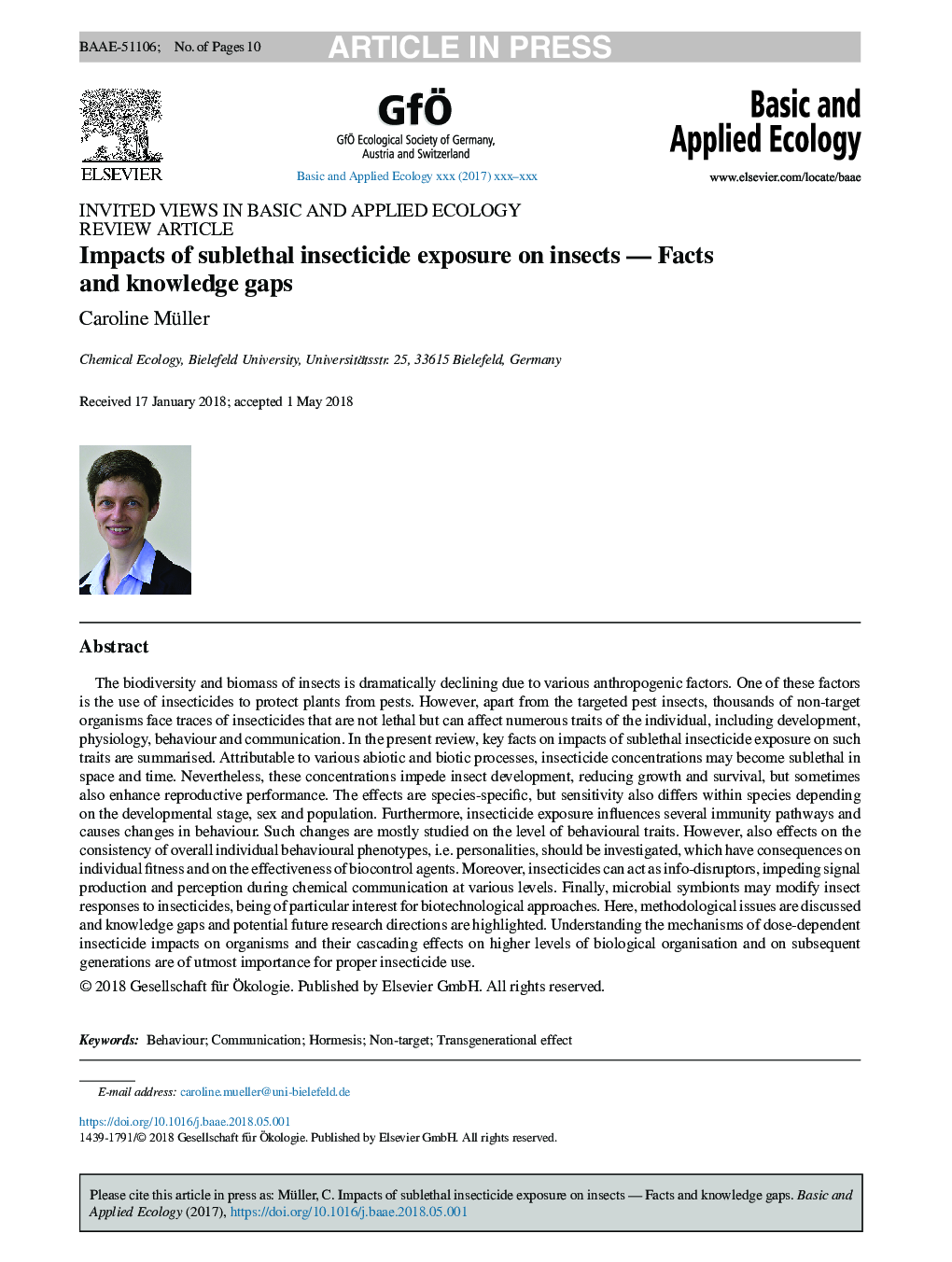| کد مقاله | کد نشریه | سال انتشار | مقاله انگلیسی | نسخه تمام متن |
|---|---|---|---|---|
| 8846966 | 1617851 | 2018 | 10 صفحه PDF | دانلود رایگان |
عنوان انگلیسی مقاله ISI
Impacts of sublethal insecticide exposure on insects - Facts and knowledge gaps
ترجمه فارسی عنوان
تأثیر حشرات حشرهکش زیرهله ای بر حشرات - آمار و شکاف دانش
دانلود مقاله + سفارش ترجمه
دانلود مقاله ISI انگلیسی
رایگان برای ایرانیان
کلمات کلیدی
رفتار - اخلاق، ارتباطات، هورمونیزم غیر هدف، اثر نسبی،
ترجمه چکیده
تنوع زیستی و زیست توده حشرات به علت عوامل مختلف انسان شناسی، به طور چشمگیری کاهش می یابد. یکی از این عوامل استفاده از حشره کش ها برای محافظت از گیاهان از آفات است. با این حال، به جز حشرات آفات هدفمند، هزاران موجود زنده غیرقانونی با اثرات حشره کش ها مواجه می شوند که کشنده نیستند، اما می توانند بر ویژگی های متعدد فرد نظیر توسعه، فیزیولوژی، رفتار و ارتباطات تاثیر بگذارد. در این بررسی، حقایق کلیدی در مورد تاثیر قرار گرفتن در معرض حشره کش های سوبستله بر روی این صفات خلاصه شده است. در فرآیندهای مختلف زیستی و زیست زیستی، غلظت حشره کش ها ممکن است در فضا و زمان به صورت زیرلطنتی تبدیل شود. با این وجود، این غلظت باعث جلوگیری از رشد حشرات، کاهش رشد و بقای آن می شود، اما گاهی اوقات همچنین باعث افزایش عملکرد تولید مثل می شود. اثرات گونه خاص هستند، اما حساسیت نیز در بین گونه ها بسته به مرحله رشد، جنس و جمعیت متفاوت است. علاوه بر این، قرار گرفتن در معرض حشره کش ها چندین مسیر ایمنی را تحت تاثیر قرار می دهد و باعث تغییر در رفتار می شود. چنین تغییراتی بیشتر در سطح صفات رفتاری مورد بررسی قرار می گیرد. با این حال، تأثیرات بر روی هماهنگی کلیه فنوتیپ های رفتاری شخصی، یعنی شخصیت ها، باید مورد بررسی قرار گیرد که پیامد آن بر آمادگی فردی و اثربخشی عوامل کنترل بیولوژیک است. علاوه بر این، حشره کش ها می توانند به عنوان اطلاعات خراب کننده عمل کنند، مانع تولید سیگنال و ادراک در طول ارتباطات شیمیایی در سطوح مختلف. در نهایت، سمیبیون های میکروبی ممکن است پاسخ های حشره ای به حشره کش ها را تغییر دهند و علاقه خاصی به رویکردهای بیوتکنولوژی داشته باشند. در اینجا، مسائل مربوط به روش شناسی مورد بحث قرار گرفته و شکاف دانش و آینده پژوهی های آینده بالقوه برجسته شده است. شناخت مکانیزم های حشره کش وابسته به دوز بر ارگانیسم ها و تاثیرات آبشار آنها بر سطح بالاتری از سازمان های بیولوژیکی و نسل های بعد از آن برای اهداف حشره کش مناسب است.
موضوعات مرتبط
علوم زیستی و بیوفناوری
علوم کشاورزی و بیولوژیک
علوم دامی و جانورشناسی
چکیده انگلیسی
The biodiversity and biomass of insects is dramatically declining due to various anthropogenic factors. One of these factors is the use of insecticides to protect plants from pests. However, apart from the targeted pest insects, thousands of non-target organisms face traces of insecticides that are not lethal but can affect numerous traits of the individual, including development, physiology, behaviour and communication. In the present review, key facts on impacts of sublethal insecticide exposure on such traits are summarised. Attributable to various abiotic and biotic processes, insecticide concentrations may become sublethal in space and time. Nevertheless, these concentrations impede insect development, reducing growth and survival, but sometimes also enhance reproductive performance. The effects are species-specific, but sensitivity also differs within species depending on the developmental stage, sex and population. Furthermore, insecticide exposure influences several immunity pathways and causes changes in behaviour. Such changes are mostly studied on the level of behavioural traits. However, also effects on the consistency of overall individual behavioural phenotypes, i.e. personalities, should be investigated, which have consequences on individual fitness and on the effectiveness of biocontrol agents. Moreover, insecticides can act as info-disruptors, impeding signal production and perception during chemical communication at various levels. Finally, microbial symbionts may modify insect responses to insecticides, being of particular interest for biotechnological approaches. Here, methodological issues are discussed and knowledge gaps and potential future research directions are highlighted. Understanding the mechanisms of dose-dependent insecticide impacts on organisms and their cascading effects on higher levels of biological organisation and on subsequent generations are of utmost importance for proper insecticide use.
ناشر
Database: Elsevier - ScienceDirect (ساینس دایرکت)
Journal: Basic and Applied Ecology - Volume 30, August 2018, Pages 1-10
Journal: Basic and Applied Ecology - Volume 30, August 2018, Pages 1-10
نویسندگان
Caroline Müller,
